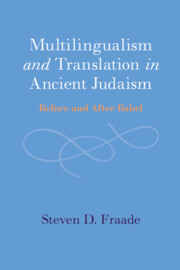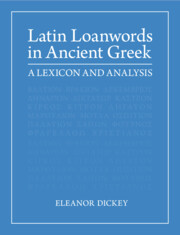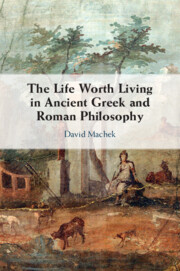83 results
Chapter 15 - Greek and Roman Art
- from Part III - Art
-
-
- Book:
- Goethe in Context
- Published online:
- 16 May 2024
- Print publication:
- 23 May 2024, pp 141-149
-
- Chapter
- Export citation
32 - Scripts
- from Part 5 - Sociolinguistic and Geographical Approaches
-
-
- Book:
- The Cambridge Handbook of Slavic Linguistics
- Published online:
- 16 May 2024
- Print publication:
- 23 May 2024, pp 675-696
-
- Chapter
- Export citation
Classical Studies Trends: teaching Classics in secondary schools in the UK
-
- Journal:
- Journal of Classics Teaching , First View
- Published online by Cambridge University Press:
- 22 February 2024, pp. 1-17
-
- Article
-
- You have access
- Open access
- HTML
- Export citation
Chapter 8 - Layout, Script and Language of the Ordo Romanus Manuscripts
- from Part III - Format and Script of the Manuscripts
-
- Book:
- Roman Liturgy and Frankish Creativity
- Published online:
- 04 January 2024
- Print publication:
- 18 January 2024, pp 207-235
-
- Chapter
- Export citation
1 - Classical Foundations
- from Part I - What is Rhetoric?
-
- Book:
- Political Rhetoric in Theory and Practice
- Published online:
- 02 November 2023
- Print publication:
- 16 November 2023, pp 11-23
-
- Chapter
- Export citation
Verbs of sexual intercourse in the Greek Pentateuch: a lexical analysis
-
- Journal:
- The Journal of Hellenic Studies / Volume 143 / November 2023
- Published online by Cambridge University Press:
- 19 October 2023, pp. 202-221
- Print publication:
- November 2023
-
- Article
-
- You have access
- Open access
- HTML
- Export citation
12 - Parameters of variation in the syntax of expressive suffixes: Case studies of Russian, German, Spanish and Greek
- from Comparative
-
-
- Book:
- Expressivity in European Languages
- Published online:
- 24 August 2023
- Print publication:
- 07 September 2023, pp 361-392
-
- Chapter
- Export citation
6 - Expressivity in Modern Greek: Some morphological mechanisms for the expression of negative emotions
- from Hellenic
-
-
- Book:
- Expressivity in European Languages
- Published online:
- 24 August 2023
- Print publication:
- 07 September 2023, pp 123-228
-
- Chapter
- Export citation
On the status of NCIs: An experimental investigation on so-called Strict NC languages
-
- Journal:
- Journal of Linguistics , First View
- Published online by Cambridge University Press:
- 25 August 2023, pp. 1-41
-
- Article
-
- You have access
- Open access
- HTML
- Export citation
Chapter 22 - Cicero and Early Dramatic Latin
- from Part IV - Reception
-
-
- Book:
- Early Latin
- Published online:
- 27 July 2023
- Print publication:
- 17 August 2023, pp 453-465
-
- Chapter
- Export citation
3 - Who’s who in the XX Palmyrenorum
-
- Book:
- Latin Military Papyri of Dura-Europos (<i>P.Dura</i> 55–145)
- Published online:
- 21 July 2023
- Print publication:
- 10 August 2023, pp 41-161
-
- Chapter
- Export citation

Multilingualism and Translation in Ancient Judaism
- Before and After Babel
-
- Published online:
- 01 August 2023
- Print publication:
- 21 September 2023
1 - The Classical Sublime
- from Part I - The Sublime before Romanticism
-
-
- Book:
- The Cambridge Companion to the Romantic Sublime
- Published online:
- 06 July 2023
- Print publication:
- 20 July 2023, pp 17-28
-
- Chapter
- Export citation

Latin Loanwords in Ancient Greek
- A Lexicon and Analysis
-
- Published online:
- 25 May 2023
- Print publication:
- 15 June 2023
Conclusions
-
- Book:
- The Life Worth Living in Ancient Greek and Roman Philosophy
- Published online:
- 29 April 2023
- Print publication:
- 27 April 2023, pp 224-232
-
- Chapter
- Export citation
11 - Multilingualism and the End of the Ottoman Empire: Language, Script, and the Quest for the ‘Modern’
-
-
- Book:
- Multilingualism and History
- Published online:
- 20 April 2023
- Print publication:
- 27 April 2023, pp 205-222
-
- Chapter
- Export citation

The Life Worth Living in Ancient Greek and Roman Philosophy
-
- Published online:
- 29 April 2023
- Print publication:
- 27 April 2023
Introduction
-
- Book:
- The Life Worth Living in Ancient Greek and Roman Philosophy
- Published online:
- 29 April 2023
- Print publication:
- 27 April 2023, pp 1-33
-
- Chapter
- Export citation
2 - ‘A Passionate Coldness’
-
- Book:
- Sexual Restraint and Aesthetic Experience in Victorian Literary Decadence
- Published online:
- 02 March 2023
- Print publication:
- 09 March 2023, pp 76-113
-
- Chapter
- Export citation
Chapter 1 - Hesiod, Virgil and the Ambitions of Georgic
- from Part I - Turnings
-
-
- Book:
- A History of English Georgic Writing
- Published online:
- 01 December 2022
- Print publication:
- 15 December 2022, pp 39-56
-
- Chapter
- Export citation



